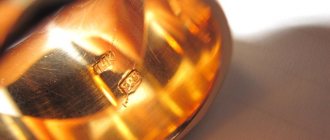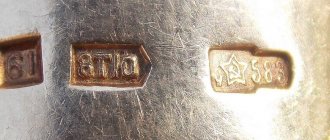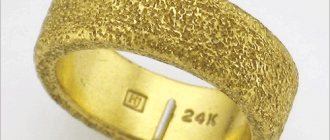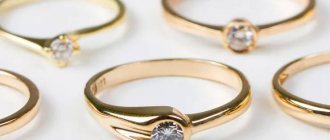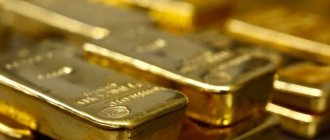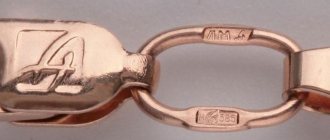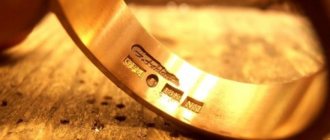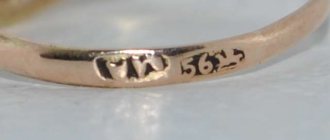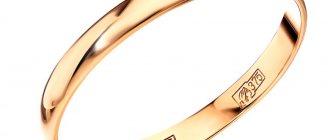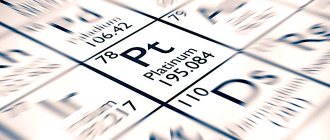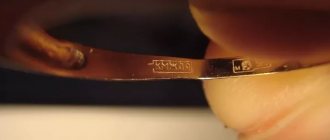Many lovers of gold jewelry still do not know that these items are made from impure metals. The true amount of precious metal is indicated using a sample.
It is generally accepted that USSR gold is bought from precious metals dealers much more than modern gold. After all, Soviet jewelry has been historically proven to be more resistant to the aggressive effects of acids.
Let's try to figure out how much better Soviet precious metals are than modern ones. Let's find out which alloy is more reliable and beautiful.
What was the standard of gold in Soviet times?
In 1922, during the formation of the USSR, a gold sampling system developed back in 1798 was used. Then the calculation was based on the Russian pound, which included 96 spools.
The famous Soviet standard is 583 gold.
Since 1927, it has lost its meaning. The metric system was adopted. According to it, the sample shows the number of milligrams of noble metal in 1 gram of alloy per 1 kg. This calculation was borrowed from Europe.
The same calculation together with foreign countries made it possible for the Union to develop in the foreign market for precious metals.
To achieve this, the process of measuring gold purity for USSR jewelry was adjusted to generally accepted standards. The selection of samples was small. The country wanted to approve a single gold standard for everyone in the 583rd standard form.
Composition and its connection to the shade of products
As was said earlier, there is a certain dependence of the color indicators of the decoration on the metal that was used for the alloy and obtaining the sample. In Soviet gold of 583 samples, accordingly, there was 58.3% pure gold, and the rest were additives in the form of silver, palladium or copper.
The table shows the color of this gold sample in the USSR in percentage terms:
| Try | Silver | Nickel | Zinc | Copper | Gold | Color |
| 583 | 8,3 | — | — | 33,4 | 58,3 | Red |
| 583 | 18,3 | — | — | 23,4 | 58,3 | Pink |
| 583 | 36,0 | — | — | 5,7 | 58,3 | Green |
| 583 | — | 17 | 8,7 | 16,0 | 58,3 | White |
Samples of precious metals in the USSR
Let's take a closer look at all Soviet gold samples.
| Systems | Application | ||
| Metric | Zolotnikovaya | Carat | |
| 1000 | 96 | 24 | Purest silver, gold, platinum |
| 999,9 | — | — | Technical metals, commercial platinum and silver |
| 980 | 94 | — | The most precious gold things |
| 958 | 92 | 23 | High quality gold in some countries |
| 950 | — | — | Platinum items |
| 916 | 88 | 22 | High quality silver items |
| 900 | — | — | Gold and silver bars, coins |
| 975 | — | — | Silver items |
| 875 | 84 | 21 | Household silver items |
| 800 | — | — | Gold and silver household items |
| 750 | 72 | 18 | World class hallmark for valuable gold standards |
| 583 | 56 | 14 | For cheap gold jewelry. |
| 500 | 48 | 12 | For inexpensive gold jewelry and silver coins of “royal mintage”. |
| 375 | 36 | — | The most inexpensive gold items |
USSR gold earrings
Changes in the mark on gold items by year
In Russia, the practice of using stamps on valuable metals originated several centuries ago.
- 1899 - the mark depicted the profile of a woman’s face turned to the left. Next to it was the sample number and the initials of the district.
- 1908 - it changed a little, the woman’s profile turned to the right.
- 1927 - the mark on USSR gold acquired a completely different look - the head of a working man with the image of a hammer in the foreground. This corresponded to the political situation of those times.
- 1958 - five-pointed star with a hammer and sickle inside.
- Until 1965, the star was convex, then it acquired a flat shape. This image existed until 1994, when it was replaced by the profile of a girl with a kokoshnik on her head.
The exceptional quality of Soviet gold: myth or truth
During the times of Tsarist Rus' and the Soviets, all jewelry enterprises and retail outlets belonged to the state, it was impossible to see counterfeit goods on the shelves
The maximum permissible violation could be +/- 5 units from the sample declared on the product. But even now jewelry is made with the same deviation standards.
Soviet products were massive. The rings did not bend from strong compression, the chains did not stretch from rough influences. There were no hollow decorations, but the cost was appropriate. Most modern products are made taking into account the financial capabilities of the consumer - inexpensive bracelets, earrings, and other jewelry quickly break due to thin materials. This is where the story about the quality of Soviet gold originated.
Turkish gold and demand for domestic jewelry products
30-40 years ago, the Soviet jewelry market was captured by Turkish products of 585 standard. The poor quality of the purchased jewelry caused a huge number of negative reviews from the population. This is not surprising, since Turkish gold was made using foil. Jewelry deteriorated before our eyes, became deformed, and completely broke due to slight mechanical impact.
The same misfortune befell precious stones imported from Turkey.
Countless complaints about counterfeit products led to a ban on their import by 2000.
Jewelry made from Turkish gold
A little later, store windows were again filled with Russian-made gold. To maintain the quality of manufactured products, GOST 6835-2002 dated August 1, 2002 was approved.
Today, the most popular Russian standard approved by this GOST is the 585th. It meets all foreign standards.
Gold content
Gold of 750 standard indicates the content of 75.5% pure gold in the alloy, all the remaining is impurities, or in other words, an alloy that may contain platinum, silver, palladium, copper and nickel. Based on the added metals, the initially yellow metal can acquire unusual shades of color: for example, bright yellow, red-pink, green and even black.
750 gold is very popular and has great sales, it is easy to process and polish, and is well suited for making jewelry. According to the foreign multiple system of 750, the purity of the yellow metal is equal to 18 carats.
750 standard is prestigious and is used in the decoration of expensive and exclusive items.
The gold alloy of this standard is considered more prestigious than others, since lower samples have a lower percentage of the precious metal. The masters of the jewelry industry, when creating their masterpieces, remain unchanged in their favorite 750 gold, which has the best reviews among clients and is a kind of “gold standard” in this area.
Having many advantages, 750 gold has some disadvantages, such as the increased softness of the alloy, which is why you need to handle it very carefully and carefully. When wearing a product, especially if it is a ring, it can easily be scratched, especially when comparing it with a product made of 585, which has much more durable properties of the alloy.
To enhance strength and hardness, palladium or nickel is added to the alloy. Palladium is a precious and very expensive metal, and it also gives gold a peculiar and unique shade. Products in this version are very expensive and only true admirers of jewelry made of precious metals can afford to buy them. Nickel is not a noble metal; its alloy is magnetic and costs much less.
Copper is similarly used as an alloy, giving the surface of the product hard properties and a red-pink color.
If the alloy in the alloy is silver, then the alloy acquires increased endurance in operation and has a green tint.
To achieve the highest performance characteristics, the method of “floating” metals is sometimes used. With this method, the solid solution decomposes into different phases, releasing the AuCu3 aggregate. That is why, if there is a need to obtain the softest metal alloy, it is subjected to additional processing.
Ring made of "white" gold.
750 gold lends itself well to processing, casting and soldering of links. It is also good to use together with colored glass enamel, where gold is used as a base. An important aspect when interacting with enamel is the mandatory content of at least sixteen percent copper in the alloy applied to the surface, failure to comply with which may result in a pale color of the outer part of the product.
The color of 750 gold is classic yellow, as well as red and white. By using such combinations and unusual carvings, you can make a truly unique ring or other piece of jewelry. You can see examples of products containing 750 gold and their photos in this article.
Using this sample you can create uniquely beautiful jewelry.
750 standard gold has properties that are resistant to most chemical irritants, with the exception of aqua regia, under the influence of which it is destroyed.
Linking the percentage of ligature to the shade of 583 samples
The idea that the color of a gold product depends on the amount of other metals used in it was developed thanks to the USSR.
Gold rings 583 samples
At that time, jewelry from 585 had a red tint, 750 had a yellow tint, and 375 had a pink tint.
As already mentioned, the color of a valuable metal is influenced by the percentage content of other metals in the product. Let's take a look at the table of color changes using sample 583 as an example.
| Silver | Nickel | Zinc | Copper | Gold | Color |
| 8,3 | — | — | 33,4 | 58,3 | Red |
| 18,3 | — | — | 23,4 | 58,3 | Pink |
| 36,0 | — | — | 5,7 | 58,3 | Green |
| — | 17 | 8,7 | 16,0 | 58,3 | White |
Features of alloys
What does the amount of metal in an alloy practically mean? First of all, this affects the physical characteristics of the material. For example, 999 gold is very soft, making earrings or rings from it is difficult. But the famous 585 is quite suitable, since the nickel, zinc and copper included in it give the alloy much greater strength and resistance to wear.
Samples of the USSR
The weight ratio affects the color. Moreover, not only quantitative, but also qualitative relationships are important here. Thus, the addition of copper to an alloy marked 585 will give the product a reddish tint, and the addition of zinc will turn the alloy white. Silver in large quantities 23.4 by 585 will give the alloy a greenish tint.
The table of gold samples in the USSR indicates quantitative data, but you should learn more about qualitative data.
| Metal | Try |
| Gold | 375, 500, 583, 585, 750, 916, 958, 999 |
| Silver | 800, 830, 875, 925, 960, 999 |
| Platinum | 585, 850, 900, 950 |
| Palladium | 500, 850 |
What information can be obtained by looking at the data in the table?
- 375 - means the presence of 38% pure metal in the alloy. Products made from it are yellow in color, but fade quite quickly, since iron sylphide appears on its surface.
- 500 – the color range varies very widely, since 50% of gold is a mixture of silver and copper and it is their ratio that gives the color.
- 585 - over time replaced 583. They differ little in color and physical characteristics - 58.3% versus 58.5%, but the first value did not meet European standards and, in the end, ceased to be used. Earrings made of 583 USSR gold, as well as rings, brooches and other jewelry are the most popular “investment” of money. Spav is very stable, durable, and does not lose color or shine under any conditions.
Hallmark 583 in the modern world: how jewelers and pawnshops evaluate it
After several decades, 583, the old standard of gold, fell from the first place in the popularity of precious metals. Today, disputes arise less and less frequently compared to 585 and 583 samples. However, the price of 585 samples is several hundred rubles per gram higher than the cost of its competitor.
Foreign jewelers speak negatively about 583 samples. However, their negative attitude is not true. 583 standard gold in the USSR, with proper maintenance, does not lose its beauty, because it has:
- radiance that does not disappear for years;
- bulkiness and reliability, which avoids damage;
- corrosion resistance.
585 gold wedding ring
What it is?
Precious metals traditionally include silver, gold and platinum. USSR 583 gold in pawnshops is still the most popular pawn, as it guarantees quality. Other metals with a positive oxidation potential, such as osmium or palladium, also fall into this category. But, since the latter are used extremely rarely, few people know about them.
Decoding the sample sign
The sample of a noble metal is its weight content in the alloy being tested. Information about this is indicated on metal ingots. By law, any alloy containing more than 30% noble metals must be assayed and properly hallmarked. This data is used in the manufacture of earrings, brooches, coins and other products, as well as when valuing them in a pawn shop.
Gold rings in a pawnshop
There are 4 systems.
- Metric - the number of milligrams in 1 g or grams in 1 kg of alloy. It has been adopted in Germany, France and other countries that have signed the convention on the control and hallmarking of products made from precious metals. There is no doubt what samples of gold were in the USSR, since the USSR, the Russian Federation and all CIS countries also support the metric system. Data on the permissible weight ratios of alloys adopted in the USSR in 1927 are contained in the table. The photo shows gold items 585.
- Carat - used mainly in the USA and Canada. The karat system is used only in relation to gold alloys and indicates the number of carats in a catchable 24 carat of the alloy being assayed. That is, a 9-carat alloy contains 0.375 g in 1 g, and a 24-carat alloy contains no less than 0.999 g, that is, it corresponds to 999 metric standards. Using the corresponding tables, it is quite easy to convert carat measurements to metric ones.
- Zolotnikovaya is purely Russian. Based on the ancient scale, according to which the value is measured by the number of spools of pure metal in relation to 96 spools - 1 pound of alloy. According to such measurements, in an alloy of 36 spools, the mass of pure gold or platinum reaches 0.375 g per 1 g of alloy, and the designation of 56 spools corresponds to 583.
- Lot - used in Germany and Britain for silver. In this case, the conventional weight unit mark contains 16 lots, in fact, 6 lots correspond to 375, 12 - 750, and 14 - 875.
Metal color chart
Tips for caring for Soviet gold
Due to alloys contained in gold, it often darkens during use. This occurs especially actively with constant contact with human skin and oxygen. To prevent such changes, you need to learn how to properly care for them.
- Stir 250 ml. soap solution with five drops of ammonia;
- We lower the product into it and leave it for twenty minutes;
- We take it and rinse it with water at room temperature;
- Next, just wipe the jewelry with a cloth or a soft toothbrush until it shines.
Do not use household chemicals when cleaning.
They may contain alkalis and acids that affect the appearance of precious metals.
Care Tips
Despite the quality and reliability of the jewelry, it tends to darken due to the ligature contained in the composition. When in contact with the human body and oxygen, gold will change; To prevent this from happening, the following actions can be included in preventive measures:
- you need to add up to 5 drops of ammonia to a glass of soap solution;
- decorations are placed in water for 20 minutes;
- Having taken out the product, wash it with ordinary tap water;
- Depending on the contamination, you need to either clean the jewelry with a soft brush or simply wipe it with a napkin until it shines.
Important! Such a product should not be exposed to aggressive substances in the form of acids and alkalis, which may be contained in household chemicals. This may ruin the appearance, making it impossible to restore the earrings or rings.
Reviews
My great-grandmother and great-grandfather passed on their former wedding rings to my sister and me. I was lucky - I got something bigger! So, when I was getting ready to get married, my groom and I decided to make their rings based on the chosen picture from the Internet. We collected all the unnecessary gold at home, including old rings. And the master made two of our rings from one great-grandfather’s ring; he didn’t need the rest of the products!
Maria P. g, Moscow
Alisa T. g, Ivanovo
I decided to say goodbye to the old gold I didn’t need (I had one earring lying around, a missing crown), and took it to the pawnshop. The buyer said that such metal is valued cheaper than modern metal. I'll try to go to another salon.
I lost my old gold chain, which I managed to buy back in Soviet times. I still can’t find something suitable for myself. Modern products seem too thin and fragile. And the thick chains still cost as much as a car.
Valentina P., Donetsk
